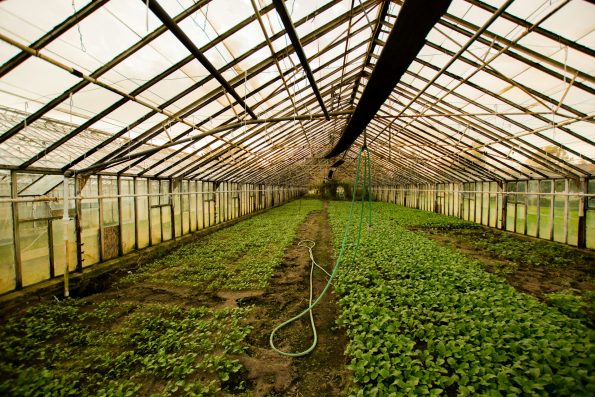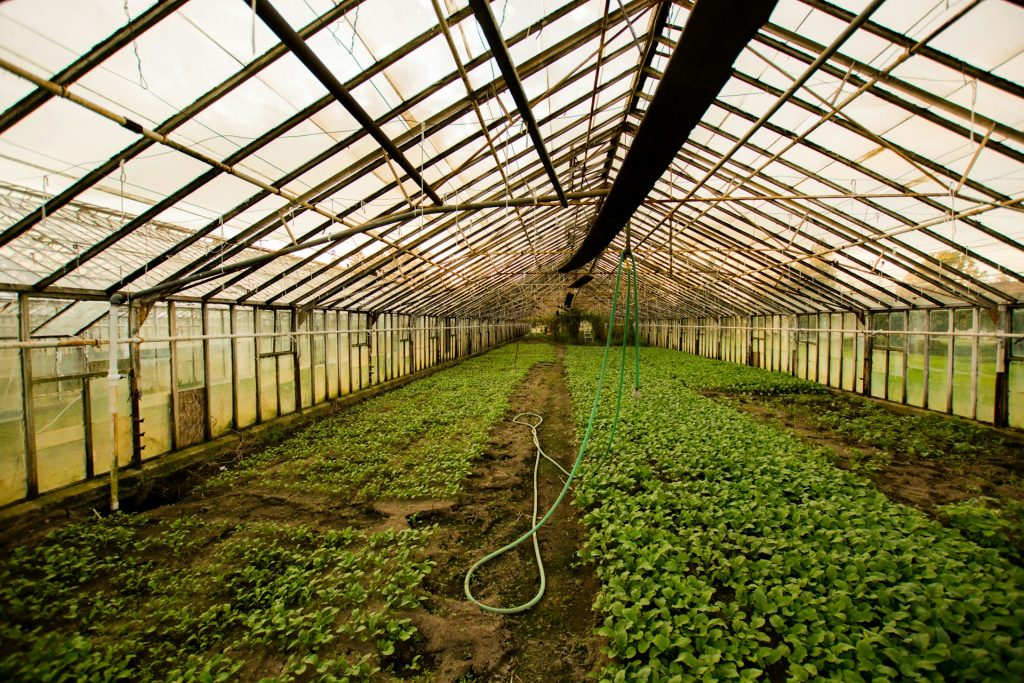Revamping Your Farmyard to a Greenhouse Farming Business
With rapid urbanization and a growing population, the amount of arable land is shrinking, leading to significant changes in agricultural practices. Statista reports that the total land area dedicated to U.S. farms has been decreasing every year since 2000. Over this period, the total area of farmland has decreased by more than 66 million acres, reaching 878.6 million acres by 2023.

https://unsplash.com/photos/greenhouse-interior-9y8c_YDUrYA
In response to this trend, greenhouse farming has surged in popularity due to its ability to create controlled growing environments.
Market trends are similarly encouraging. According to Grand View Research, the U.S. greenhouse market was valued at USD 2910.7 million in 2023. It is expected to grow at a CAGR of 8.8% from 2024 to 2030.
If you own a farmyard and are considering transforming it into a greenhouse farming business, now might be the ideal time. Transitioning from traditional farming to greenhouse farming can revolutionize your operations, providing extended growing seasons, reduced pest infestations, and enhanced water efficiency.
This comprehensive guide will walk you through the key steps involved in revamping your farmyard into a thriving greenhouse farming business.
Assessing Your Farmyard and Planning
The first step in transforming your farmyard is a thorough assessment and detailed planning. Consider the following:
Space and Location
Evaluate the available space and choose a location that receives ample sunlight, has good drainage, and is accessible for maintenance and transport. This ensures optimal conditions for your greenhouse farming business, supporting healthy plant growth and efficient operations. Additionally, consider proximity to markets or distribution centers to minimize transportation costs and maximize freshness for your produce.
Climate and Crops
Understanding your local climate is crucial when deciding which crops to grow. While greenhouses can extend the growing season, it’s important to choose crops that thrive in controlled environments.
Forbes suggests that if you’re unsure where to start, consider beginning with salad vegetables. They are easy to grow and yield high returns, particularly in the spring and summer seasons. Tomatoes, peppers, and eggplants are also ideal for greenhouses, flourishing in the warm conditions provided by these structures.
Budget
Outline a budget that includes initial setup costs, ongoing operational expenses, and potential contingencies.
The cost of building a greenhouse rises with its square footage, but the price per square foot decreases as the total area increases. While the overall cost is higher, the increase in cost is not exponential.
On average, medium-sized greenhouses cost around $25 per square foot, as reported by Forbes. Large commercial greenhouses, typically with plastic or fiberglass over a steel framework, cost between $2 and $4 per square foot, including ventilation and plumbing.
Deciding on the Greenhouse Structure
Choosing the correct greenhouse structure is essential for the success of your project. There are several types of greenhouses to consider:
- Freestanding Greenhouses: Ideal for larger spaces, these standalone structures offer maximum light exposure and can be easily expanded.
- Lean-to Greenhouses: Attached to an existing building, these are space-efficient and benefit from the structural support and insulation of the adjacent building.
- Hoop Houses: Made from metal or PVC pipes covered with plastic sheeting, these are cost-effective and easy to construct.
Consider factors such as durability, insulation, and ventilation when choosing your greenhouse structure.
Installing the Greenhouse
Once you’ve chosen your greenhouse, it’s time to install it. This involves several steps:
- Site Preparation: Clear the area of debris and level the ground. Having equipment such as mini excavators for rent can significantly streamline the process, making it both easier and more efficient.
You can rent this equipment on a weekly basis. For smaller jobs, SitePro Rentals notes that you can rent them for a single day, providing flexibility to match your project’s needs.
- Foundation: Depending on the greenhouse type, you may need to lay a foundation. This could be a simple wooden frame or a concrete slab for more permanent structures.
- Assembling the Structure: Follow the manufacturer’s instructions to assemble the greenhouse. Ensure that all joints are secure and the structure is stable.
Equipping Your Greenhouse
Equipping your greenhouse with the right tools and systems is essential for optimal plant growth. Key components include:
- Irrigation System: Drip irrigation systems are known for their efficiency in conserving water. According to the University of Rhode Island, unlike other irrigation methods like sprinklers, which are only 65-75% efficient, drip irrigation is much more effective. It has an efficiency rate of up to 90% in delivering water directly to plants.
This method significantly reduces runoff and evaporation. To ensure consistent watering, it’s recommended that automated timers be installed.
- Ventilation and Heating: Proper ventilation prevents overheating and ensures air circulation. Depending on your climate, you may also need heating systems to maintain optimal temperatures.
- Lighting: Supplemental lighting may be necessary during shorter days or for certain crops. LED grow lights are energy-efficient and effective.
- Shelving and Benches: Install sturdy shelves and benches to maximize space and organize plants.
Soil and Planting
Choosing the right soil and planting methods will impact your greenhouse’s productivity:
- Soil Selection: Use high-quality, well-draining soil. Consider soil testing to ensure the right nutrient balance.
- Planting Techniques: Opt for raised beds or containers to improve drainage and prevent soil compaction. Implement crop rotation and companion planting to maintain soil health.
Pest and Disease Management
One of the benefits of greenhouse farming is reduced pest problems, but it’s still essential to monitor and manage pests and diseases:
- Integrated Pest Management (IPM): Use a combination of biological, mechanical, and chemical methods to control pests. Introduce beneficial insects like ladybugs and predatory mites.
- Monitoring: Consistently inspect plants for indications of pests or disease. Detecting and intervening early is essential.
Marketing and Selling Your Produce
To ensure the profitability of your greenhouse farming business, you need effective marketing and sales strategies:
- Local Markets: Sell your produce at farmers’ markets, local grocery stores, and restaurants. Develop connections with local businesses to ensure consistent orders.
- Community Supported Agriculture (CSA): Offer subscription services where customers pay upfront for a season’s worth of produce. This provides steady income and builds customer loyalty.
- Online Sales: Set up an online store to reach a wider audience. Consider offering home delivery or pickup services.
FAQs
What are the benefits of using drip irrigation systems?
Drip irrigation systems are very effective in saving water compared to methods like sprinklers. They supply water directly to plant roots, decreasing runoff and evaporation. This approach helps maintain soil moisture and encourages better plant growth.
What is a hoop house?
A hoop house, also known as a high tunnel or polytunnel, is made from a series of hoops. These hoops are covered with plastic or similar material to create a greenhouse structure. It is designed to extend the growing season and protect plants from harsh weather conditions.
What is the duration for which I can rent construction equipment?
Construction equipment rentals typically offer flexible rental periods, ranging from daily, weekly, and monthly rentals to longer-term leases. The rental period can be customized to match the duration of your project.
In summary, revamping your farmyard into a greenhouse farming business is a significant but rewarding undertaking. By careful planning, you can create a productive and profitable agricultural enterprise.
Embrace the opportunities that greenhouse farming offers and enjoy the benefits of higher yields, extended growing seasons, and improved quality of produce.
With dedication and smart strategies, your greenhouse farming business can flourish and contribute to the growing demand for fresh, local, and sustainable food.

